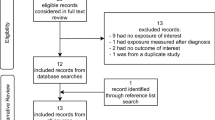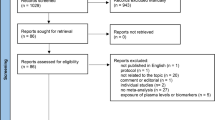Abstract
Purpose
Folate, vitamins B6 and B12, methionine, choline, and betaine are nutrients related to one-carbon metabolism and have been hypothesized to decrease cancer risk. Few studies have evaluated dietary intakes of these nutrients in relation to renal cell cancer (RCC).
Methods
We conducted prospective follow-up studies of women in the Nurses’ Health Study and men in the Health Professionals Follow-up Study. Diet was assessed repeatedly using a validated semi-quantitative food-frequency questionnaire in both studies.
Results
During follow-up of 24 years among 77,208 women (918,891 person-years) and 22 years among 47,886 men (1,731,752 person-years), we accrued 436 cases of RCC (225 women and 211 men). Intakes of folate, vitamins B6 and B12, methionine, and betaine were not found to be related to RCC risk. Higher intake of free choline, but not other forms of choline, was associated with reduced RCC risk. The results were similar in men and women.
Conclusions
We found little evidence that higher intakes of nutrients related to one-carbon metabolism lower RCC risk. One-carbon metabolism may have little influence on renal carcinogenesis.
Similar content being viewed by others
References
Siegel R, Naishadham D (2012) Jemal A (2012) Cancer statistics. CA Cancer J Clin 62(1):10–29. doi:10.3322/caac.20138
Curti BD (2004) Renal cell carcinoma. JAMA 292(1):97–100
Simard EP, Ward EM, Siegel R, Jemal A (2012) Cancers with increasing incidence trends in the United States: 1999 through 2008. CA Cancer J Clin. doi:10.3322/caac.20141
Hock LM, Lynch J, Balaji KC (2002) Increasing incidence of all stages of kidney cancer in the last 2 decades in the United States: an analysis of surveillance, epidemiology and end results program data. J Urol 167(1):57–60
Mason JB (2003) Biomarkers of nutrient exposure and status in one-carbon (methyl) metabolism. J Nutr 133(Suppl 3):941S–947S
Blount BC, Mack MM, Wehr CM, MacGregor JT, Hiatt RA, Wang G, Wickramasinghe SN, Everson RB, Ames BN (1997) Folate deficiency causes uracil misincorporation into human DNA and chromosome breakage: implications for cancer and neuronal damage. Proc Natl Acad Sci USA 94:3290–3295
Choi SW, Kim YI, Weitzel JN, Mason JB (1998) Folate depletion impairs DNA excision repair in the colon of the rat. Gut 43(1):93–99
Bosetti C, Scotti L, Maso LD, Talamini R, Montella M, Negri E, Ramazzotti V, Franceschi S, La Vecchia C (2007) Micronutrients and the risk of renal cell cancer: a case-control study from Italy. Int J Cancer 120(4):892–896. doi:10.1002/ijc.22374
Brock KE, Ke L, Gridley G, Chiu BC, Ershow AG, Lynch CF, Graubard BI, Cantor KP (2011) Fruit, vegetables, fibre and micronutrients and risk of US renal cell carcinoma. Br J Nutr:1–9. doi:10.1017/S0007114511006489
Colditz GA, Hankinson SE (2005) The Nurses’ Health Study: lifestyle and health among women. Nat Rev Cancer 5(5):388–396
Stampfer MJ, Willett WC, Speizer FE, Dysert DC, Lipnick R, Rosner B, Hennekens CH (1984) Test of the national death index. Am J Epidemiol 119(5):837–839
Smith-Warner SA, Spiegelman D, Ritz J, Albanes D, Beeson WL, Bernstein L, Berrino F, van den Brandt PA, Buring JE, Cho E, Colditz GA, Folsom AR, Freudenheim JL, Giovannucci E, Goldbohm RA, Graham S, Harnack L, Horn-Ross PL, Krogh V, Leitzmann MF, McCullough ML, Miller AB, Rodriguez C, Rohan TE, Schatzkin A, Shore R, Virtanen M, Willett WC, Wolk A, Zeleniuch-Jacquotte A, Zhang SM, Hunter DJ (2006) Methods for pooling results of epidemiologic studies: the pooling project of prospective studies of diet and cancer. Am J Epidemiol 163(11):1053–1064. doi:10.1093/aje/kwj127
US Department of Agriculture (1989) Composition of foods-raw, processed, and prepared, 1963–1988. In: Agricultural Handbook No. 8 Series. Department of Agriculture, Government Printing Office, Washington, D.C
US Department of Agriculture (2004) USDA database for the Choline Content of Common Foods. US Department of Agriculture. http://www.nal.usda.gov/fnic/foodcomp/Data/Choline/Choline.html
Zeisel SH, Mar MH, Howe JC, Holden JM (2003) Concentrations of choline-containing compounds and betaine in common foods. J Nutr 133(5):1302–1307
Zeisel SH, Mar M-H, Howe JM, Holden JM (2003) Erratum: concentrations of choline-containing compounds and betaine in common foods J. Nutr. 133:1302–1307. J Nutr 133:2918–2919
Willett W, Stampfer MJ (1986) Total energy intake: implications for epidemiologic analyses: review. Am J Epidemiol 124(1):17–27
Rimm EB, Giovannucci EL, Stampfer MJ, Colditz GA, Litin LB, Willett WC (1992) Reproducibility and validity of an expanded self-administered semiquantitative food frequency questionnaire among male health professionals. Am J Epidemiol 135(10):1114–1126
Willett WC, Sampson L, Stampfer MJ, Rosner B, Bain C, Witschi J, Hennekens CH, Speizer FE (1985) Reproducibility and validity of a semiquantitative food frequency questionnaire. Am J Epidemiol 122(1):51–65
Giovannucci E, Stampfer MJ, Colditz GA, Rimm EB, Trichopoulos D, Rosner BA, Speizer FE, Willett WC (1993) Folate, methionine, and alcohol intake and risk of colorectal adenoma. J Natl Cancer Inst 85(11):875–884
Cho E, Zeisel SH, Jacques P, Selhub J, Dougherty L, Colditz GA, Willett WC (2006) Dietary choline and betaine assessed by food-frequency questionnaire in relation to plasma total homocysteine concentration in the Framingham offspring study. Am J Clin Nutr 83(4):905–911
Chiuve SE, Giovannucci EL, Hankinson SE, Zeisel SH, Dougherty LW, Willett WC, Rimm EB (2007) The association between betaine and choline intakes and the plasma concentrations of homocysteine in women. Am J Clin Nutr 86(4):1073–1081
Colditz GA, Martin P, Stampfer MJ, Willett WC, Sampson L, Rosner B, Hennekens CH, Speizer FE (1986) Validation of questionnaire information on risk factors and disease outcomes in a prospective cohort study of women. Am J Epidemiol 123(5):894–900
Storkel S, Eble JN, Adlakha K, Amin M, Blute ML, Bostwick DG, Darson M, Delahunt B, Iczkowski K (1997) Classification of renal cell carcinoma: workgroup No. 1. Union Internationale Contre le Cancer (UICC) and the American Joint Committee on Cancer (AJCC). Cancer 80(5):987–989
Hu FB, Stampfer MJ, Rimm EB, Ascherio A, Rosner BA, Spiegelman D, Willett WC (1999) Dietary fat and coronary heart disease: a comparison of approaches for adjusting for total energy intake and modeling repeated dietary measurements. Am J Epidemiol 149:531–540
Prentice RL (1978) The analysis of failure times in the presence of competing risks. Biometrics 34:541–554
Therneau TM (1997) Extending the Cox Model. In: Lin DY, Fleming TR (eds) Proceedings of the first Seattle symposium in biostatistics: survival analysis. Springer, New York, pp 51–84
Rosner B (2000) Fundamentals of biostatistics, 5th edn. Duxbury Press, Boston
DerSimonian R, Laird N (1986) Meta-analysis in clinical trials. Control Clin Trials 7:177–188
Gibson TM, Weinstein SJ, Mayne ST, Pfeiffer RM, Selhub J, Taylor PR, Virtamo J, Albanes D, Stolzenberg-Solomon R (2010) A prospective study of one-carbon metabolism biomarkers and risk of renal cell carcinoma. Cancer Causes Control 21(7):1061–1069. doi:10.1007/s10552-010-9534-5
Cho E, Willett WC, Colditz GA, Fuchs CS, Wu K, Chan AT, Zeisel SH, Giovannucci EL (2007) Dietary choline and betaine and the risk of distal colorectal adenoma in women. J Natl Cancer Inst 99(16):1224–1231
Cho E, Holmes MD, Hankinson SE, Willett WC (2010) Choline and betaine intake and risk of breast cancer among post-menopausal women. Br J Cancer 102(3):489–494. doi:10.1038/sj.bjc.6605510
Cho E, Holmes M, Hankinson SE, Willett WC (2007) Nutrients involved in one-carbon metabolism and risk of breast cancer among premenopausal women. Cancer Epidemiol Biomarkers Prev 16(12):2787–2790
Lee JE, Giovannucci E, Fuchs CS, Willett WC, Zeisel SH, Cho E (2010) Choline and betaine intake and the risk of colorectal cancer in men. Cancer Epidemiol Biomarkers Prev 19(3):884–887. doi:1055-9965.EPI-09-1295
Kotsopoulos J, Hankinson SE, Tworoger SS (2010) Dietary betaine and choline intake are not associated with risk of epithelial ovarian cancer. Eur J Clin Nutr 64(1):111–114. doi:10.1038/ejcn.2009.109
Lee JE, Giovannucci E, Smith-Warner SA, Spiegelman D, Willett WC, Curhan GC (2006) Total fluid intake and use of individual beverages and risk of renal cell cancer in two large cohorts. Cancer Epidemiol Biomarkers Prev 15(6):1204–1211
Acknowledgments
This study was supported by research grant CA87969 and CA55075 from the National Institutes of Health. In addition, we would like to thank the participants and staff of the Nurses’ Health Study and the Health Professionals Follow-up Study for their valuable contributions as well as the following state cancer registries for their help: AL, AZ, AR, CA, CO, CT, DE, FL, GA, ID, IL, IN, IA, KY, LA, ME, MD, MA, MI, NE, NH, NJ, NY, NC, ND, OH, OK, OR, PA, RI, SC, TN, TX, VA, WA, WY.
Author information
Authors and Affiliations
Corresponding author
Electronic supplementary material
Below is the link to the electronic supplementary material.
Rights and permissions
About this article
Cite this article
Cho, E., Giovannucci, E.L. & Joh, HK. Nutrients related to one-carbon metabolism and risk of renal cell cancer. Cancer Causes Control 24, 373–382 (2013). https://doi.org/10.1007/s10552-012-0123-7
Received:
Accepted:
Published:
Issue Date:
DOI: https://doi.org/10.1007/s10552-012-0123-7




